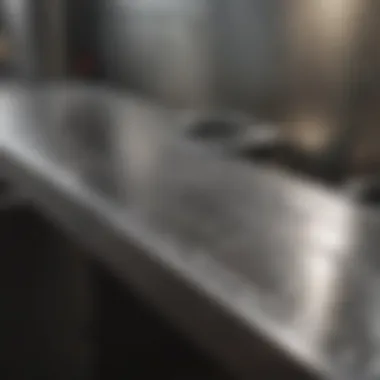Expert Tips for Cleaning Stainless Steel Equipment


Intro
This article explores effective cleaning methods for stainless steel. We will examine the daily maintenance procedures, the most suitable cleaning agents, tools needed for effective cleanup, as well as techniques for tackling stubborn stains. More importantly, we will outline best practices to preserve the finish quality, ensuring that your restaurant equipment not only looks appealing but also lasts longer. By following these strategies, culinary professionals and maintenance teams can uphold the high standards expected in the food service industry.
Understanding Stainless Steel
Stainless steel is a critical material in the food service industry. Its unique properties make it ideal for restaurant equipment. Knowing how stainless steel is composed and what makes it valuable can enhance cleaning practices and equipment maintenance. Its composition and characteristics affect how it withstands daily use and how to best care for it.
Composition of Stainless Steel
Nickel and Chromium
Nickel and chromium are vital elements in stainless steel. They interact to provide a high level of corrosion resistance. Nickel enhances ductility, while chromium forms a protective layer against oxidation. This combination makes stainless steel a popular choice for kitchen environments. It stays shiny and functional under demanding conditions.
A distinctive feature of nickel is its ability to enhance the strength of stainless steel at high temperatures. This means ovens or grills maintain their integrity even under stress. However, the main disadvantage is the increased cost due to these elements.
Corrosion Resistance
Corrosion resistance is a hallmark of stainless steel, critical for restaurant equipment that frequently comes in contact with water and food acids. The protective chromium layer repels oxygen, which is vital in preventing rust. Its effectiveness makes stainless steel a durable choice for food service environments.
A significant benefit is that stainless steel rarely needs replacement due to corrosion. However, it is essential to note that even stainless steel can corrode if not maintained properly.
Common Grades Used in Restaurants
Different grades of stainless steel serve various needs in restaurants. The most common are 304 and 316 stainless steel. Grade 304 offers good corrosion resistance and is often used in food processing and kitchen appliances. Grade 316, on the other hand, contains molybdenum, providing enhanced resistance to chlorides, making it suitable for coastal environments.
These grades ensure a long life for kitchen equipment. The downside may be the cost since higher grades cost more due to their improved properties.
Properties of Stainless Steel
Durability
Durability is a critical property of stainless steel. It withstands the challenges of high-impact environments typical in restaurants. This sturdiness ensures that equipment continues to perform over time, which is crucial for kitchen efficiency.
The characteristic of being resistant to dents and scratches contributes to its durable nature. However, misuse can still lead to unexpected damages, which may require repairs or replacements.
Ease of Maintenance
Ease of maintenance makes stainless steel a favored option. Cleaning stainless steel surfaces is straightforward and requires less effort compared to other materials. A damp cloth often suffices to clean most surfaces. This quality supports compliance with health standards in food service.
However, while maintenance is easy, using harsh chemicals can damage the finish. Understanding the right products is essential.
Aesthetic Appeal
Aesthetic appeal is another strong point for stainless steel. Its shiny surface is visually appealing and conveys cleanliness. This aesthetic is important in open kitchens where customers value a clean look.
The unique feature of stainless steel is its adaptability to various design themes. It fits both modern and traditional restaurant designs. Nevertheless, the need for constant cleaning to maintain its appearance can be viewed as a drawback by some.
Importance of Cleaning Stainless Steel Equipment
Cleaning stainless steel equipment in restaurants holds vital significance. This ensures not only hygiene but also the appearance of the equipment. In an environment where food safety is a priority, maintaining clean surfaces directly contributes to preventing health risks. The aesthetic value of well-maintained stainless steel reflects professionalism, which is critical in the food industry.
Health and Safety Standards
Preventing Bacterial Growth
A primary concern in any kitchen is preventing bacterial growth. Stainless steel surfaces can harbor bacteria if not properly cleaned. With the right cleaning procedures, restaurant operators can effectively eliminate these harmful organisms. Regular cleaning with appropriate agents is essential in creating a safe environment. Since stainless steel is non-porous, it can be easily wiped down, allowing for a thorough sanitation. This characteristic makes it a preferred choice in kitchens across the globe.
It is important to note that the cleaning solutions used must be effective against a broad spectrum of bacteria. This not only aids in immediate sanitation but also helps in maintaining a continuously safe cooking environment.
Compliance with Health Regulations


Compliance with health regulations is another crucial aspect of maintaining stainless steel equipment. Regulatory bodies set stringent standards for cleanliness to ensure public health safety. Meeting these standards protects both the customers and the restaurant’s reputation.
Using hygienic practices is beneficial and sometimes legally required. Inspections are common, and failure to comply can result in fines or even closure. Moreover, following these regulations is part of creating a trustworthy establishment, boosting customer confidence.
Maintaining Equipment Longevity
Care Procedures
Implementing proper care procedures is essential for the longevity of stainless steel equipment. Regular maintenance routines, such as proper cleaning and polishing, can prevent surface degradation over time. For instance, using soft cloths avoids scratches that can accumulate dirt, making future cleaning more difficult.
Attention to detail in care procedures ensures equipment remains functional and visually appealing, which ties back into the overall success of the establishment. This practice can extend the life of high-value equipment, avoiding frequent replacements.
Cost Efficiency
Cost efficiency is a fundamental consideration for restaurant owners. Investing time and resources in maintaining stainless steel equipment leads to long-term savings. Proper cleaning and care can prevent the need for costly repairs or replacements, thus maximizing the value of investments in equipment.
Routine Cleaning Procedures
Routine cleaning procedures are crucial for the maintenance and functionality of stainless steel restaurant equipment. These procedures ensure that food surfaces are clean, safe, and hygienic for both staff and customers. Regular cleaning helps to prolong the lifespan of equipment and maintain its aesthetic appeal. It also reduces the buildup of grease, grime, and bacteria which can pose health risks.
Adhering to routine cleaning practices can increase operational efficiency. When equipment is clean, it is easier to monitor performance and identify any potential issues before they become serious problems. Additionally, consistent cleaning can result in improved customer satisfaction, as cleanliness is often directly associated with the quality of food and service.
Daily Cleaning Regimens
Daily cleaning regimens form the backbone of an effective maintenance schedule for stainless steel equipment. They involve simple actions that can lead to significant improvements in hygiene standards and equipment longevity. Such practices include surface wiping and equipment shutdown protocols.
Surface Wiping
Surface wiping is important for removing daily spills and residues from equipment surfaces. This practice involves using a suitable cleaning cloth saturated with a cleaning solution to effectively remove dirt and food particles. The key characteristic of surface wiping is its ease of execution. It can be performed quickly and requires minimal training, making it a beneficial choice for busy restaurant staff.
One unique feature of surface wiping is its ability to provide immediate cleanliness. By regularly wiping down surfaces, restaurant operators ensure that dirt and bacteria do not have a chance to accumulate. However, using the wrong cleaning materials, such as abrasive sponges, can cause scratches on the stainless steel, compromising its shine and finish. Therefore, it's important to select soft cloths to avoid any unintended damage.
Equipment Shutdown Protocols
Equipment shutdown protocols are equally essential in routine cleaning. These protocols dictate the procedures to follow when equipment is turned off for cleaning. The key characteristic here is that they establish safe and methodical steps, ensuring that no safety hazards occur while cleaning.
Implementing shutdown protocols helps to protect staff and maintain equipment integrity. For example, shutting down equipment before cleaning prevents accidents such as accidental burns or electric shocks. The unique feature of these protocols is their emphasis on ensuring that equipment is not only cleaned properly but is also safe to operate once put back in action. The only disadvantage might be the time taken to follow these procedures, which can delay operations during busy hours.
Weekly Deep Cleaning Tasks
Weekly deep cleaning tasks are critical in maintaining the condition of stainless steel restaurant equipment. These tasks involve more thorough cleaning activities aimed at getting rid of deeper grime that daily cleaning may miss. Important components include disassembling equipment for thorough cleaning and the use of mild detergents.
Disassembling Equipment for Thorough Cleaning
Disassembling equipment for thorough cleaning allows access to hard-to-reach areas where dust and grease can accumulate. This aspect is important because many times, regular surface cleaning may not completely eradicate dirt present within component parts. The main characteristic of this method is that it promotes an in-depth cleaning routine that addresses hidden contaminants.
By carefully taking apart equipment, operators can ensure that every component is cleaned properly, reducing the risk of food contamination and mechanical failure. One unique feature is the opportunity for operators to inspect equipment parts closely for potential repairs. A possible downside is that disassembly may require additional time and care to avoid damaging any components, especially if personnel are not adequately trained.
Use of Mild Detergents
The use of mild detergents plays an essential role in cleaning stainless steel equipment. These cleaning agents are formulated to effectively remove stains and grease without damaging the stainless steel surface. Their key characteristic is their non-abrasive nature, making them a safe choice for maintaining equipment appearance.
Using mild detergents helps preserve the finish of stainless steel while ensuring thorough cleaning. Many operators prefer mild detergents due to their effectiveness and reduced risk of damaging surfaces. A unique feature of these detergents is that they are often environmentally friendly, aligning with sustainability practices in modern restaurant operations. However, one possible drawback is that they may not be strong enough for heavy-duty cleaning tasks, necessitating the use of stronger cleaning solutions for heavily soiled equipment.
Materials for Effective Cleaning
Recommended Cleaning Solutions
Commercial vs. Homemade Cleaners
Commercial cleaners are often formulated specifically for stainless steel, making them effective in tackling tough stains and residue. They usually contain chemicals that help dissolve grease and dirt quickly, making cleaning more efficient. On the other hand, homemade cleaners are typically simpler, using ingredients like vinegar, baking soda, or lemon juice. While these can be effective for light cleaning, they might not remove more persistent stains as swiftly.
When evaluating both options, it's important to consider the specific cleaning challenges faced in restaurants. Commercial cleaners tend to offer consistent results and often come with explicit instructions that cater to industrial needs. Homemade cleaners, while cost-effective, lack the potency of commercial solutions but can be a good alternative for maintaining everyday cleanliness.


pH Neutral Detergents
pH neutral detergents are ideal for cleaning stainless steel because they do not contain harsh acids or alkalinity, preventing damage to the surface. These types of detergents maintain the sheen of stainless steel while effectively removing contamination. Moreover, their balanced chemical structure makes them safe for frequent use without risking corrosion.
Utilizing pH neutral detergents helps maintain the longevity of the equipment and ensures compliance with health cleanliness standards. They are especially pivotal in environments with stringent health regulations, as they effectively eliminate bacteria and pathogens without leaving harmful residues.
Essential Cleaning Tools
Soft Cloths and Sponges
Soft cloths and sponges are essential tools in the cleaning regime for stainless steel. Their gentle texture ensures that surfaces are not scratched or damaged during the cleaning process. These materials are perfect for daily maintenance, allowing for smooth application of cleaners without leaving any fibers or residues.
Using high-quality microfiber cloths can enhance cleaning efficiency, capturing dust and grime effectively. This prevents cross-contamination and ensures surfaces are left sparkling clean without streaks, which is vital for both hygiene and presentation in a restaurant setting.
Brushes for Stubborn Stains
When facing tougher stains, brushes specifically designed for stainless steel become necessary. They typically feature soft bristles that can safely scrub away stubborn grease or food particles without scratching the metal. This combination of efficacy and gentleness makes them a valuable tool in any maintenance staff's arsenal.
There are benefits to using brushes for tough cleaning tasks. They save time and elbow grease while still being effective at reaching crevices or corners that other tools may miss. However, it is crucial to select the right type of brush since overly abrasive options can damage the surface, compromising the equipment's appearance and integrity.
Special Techniques for Stubborn Stains
Cleaning stainless steel equipment in restaurants involves dealing with various challenges. Among these, stubborn stains such as grease, water spots, and fingerprints are notable offenders. These stains not only detract from the equipment's appearance but can also affect hygiene. Utilizing effective techniques to tackle these stains is crucial in maintaining both aesthetics and functionality.
Tackling Tough Grease
Grease buildup is common in kitchen environments. The presence of cooking oils can create an unsightly layer on equipment. This layer, if not addressed, can become difficult to remove.
Application Methods
The method of application significantly affects cleaning efficacy. For instance, using a soft cloth to apply a degreasing agent helps ensure an even distribution. This is essential to avoid missing spots. Another effective method involves spraying the cleaner directly onto the stained surface. This method allows for controlled application and minimizes excess cleaner, which can leave a residue if not rinsed properly.
The key characteristic of these application methods is versatility. They adapt well to various surfaces, ensuring that stainless steel is properly cleaned without damage. The unique feature here is the proactive approach to applying cleaners. Instead of merely wiping, coating the surface allows for better penetration of the cleaning agents into the grease.
However, a disadvantage could be the time investment required. Spraying often necessitates leaving the product on the surface for a specific duration. This waiting period can be inconvenient, especially during busy hours.
Time Considerations
Timing plays a vital role in effective cleaning. Allowing cleaning solutions to sit on stains for the appropriate duration enhances their effectiveness. Most degreasers require a contact time of several minutes to achieve full efficacy. This characteristic makes time management important in a restaurant setting.
The advantage of mindful time consideration is noticeable results. If applied correctly, stains lift away more easily after the solution has had time to work. The downside is that waiting might not always be feasible in fast-paced situations. Thus, balancing time and effectiveness is essential for optimal results.
Removing Water Spots and Fingerprints
Water spots and fingerprints are other common challenges in stainless steel maintenance. Frequent contact leaves marks that detract from the overall appearance. Addressing these stains requires targeted techniques.
Best Practices
Establishing best practices is crucial for effective cleaning. One recommended practice is to use microfiber cloths with a cleaner designed for stainless steel. Microfiber allows for lint-free cleaning and creates less friction, which minimizes scratching. The key advantage lies in the non-abrasive nature of these cloths. They ensure a polished finish, reducing the risk of damage.
Additionally, utilizing an appropriate stainless steel cleaner provides a protective layer against future stains. However, the downside could be the cost of specialty cleaners, which might not always be budget-friendly for all establishments.
Prevention Strategies
Preventive measures can significantly reduce the frequency of stains such as water spots and fingerprints. One effective strategy is the practice of immediate wiping after use. This simple step prevents moisture from drying and creating spots. The characteristic of this strategy is its proactive nature—addressing the issue before it becomes a persistent problem.
Implementing a routine cleaning schedule focuses on minor maintenance. Even though it may seem trivial, regular checks can extend the time between deep cleans. The unique advantage is that it requires minimal effort but yields significant results. However, the challenge is ensuring all staff members consistently follow these practices, which may require additional training.
Regular attention to stains will keep restaurant equipment looking its best and maintain hygiene standards.
Preventive Maintenance for Stainless Steel
Preventive maintenance plays a vital role in ensuring that stainless steel restaurant equipment remains in optimal condition. Regular care helps to avoid costly repairs and replacements, thereby enhancing the longevity of the equipment. By implementing a structured maintenance schedule, restaurant operators can preserve the equipment's appearance and functionality. Moreover, preventive maintenance helps to meet health and safety regulations, thereby fostering a clean and sanitary environment.


Regular Inspections
Regular inspections are essential for identifying wear and tear on stainless steel surfaces. This practice can often reveal issues before they escalate into significant problems. An effective inspection routine allows staff to spot scratches, dents, or corrosion early. These observations help inform the needed actions, whether it is minor touch-ups or more involved repairs.
Identifying Wear and Tear
Identifying wear and tear involves a methodical approach. Regular checks of surfaces, seams, and joints can highlight areas needing attention. This process is beneficial as it promotes proactive rather than reactive maintenance. The key characteristic of this practice is its focus on early detection, which preserves both hygiene and aesthetics. One advantage of identifying these issues timely is that it can save on repair costs later by addressing concerns early.
Prompt Repairs
Prompt repairs are crucial for maintaining the integrity of equipment. When problems are identified, timely actions can prevent further deterioration. Immediate repairs can also reduce the risk of downtime in operations. The characteristic of prompt repairs lies in their urgent nature, addressing issues as they arise. This approach is popular among restaurant managers looking to minimize disruptions. One feature that stands out about prompt repairs is their ability to enhance safety and compliance with regulations.
Protective Coatings
The use of protective coatings is another effective strategy for maintaining stainless steel surfaces. Coatings contribute significantly to the longevity of equipment by creating a barrier against contaminants and damage. This strategy is beneficial since it helps to maintain aesthetic quality while ensuring functionality. Additionally, protective coatings can lessen the amount of cleaning needed, as they repel dirt and grease.
Selecting Coatings
Selecting coatings involves careful consideration of purpose and compatibility with existing materials. Various types of coatings are available, including waxes, films, and sprays. The choice of coating is crucial for achieving desired protection levels. The key characteristic of effective coatings is their ability to enhance durability. Selecting the right coating can extend the lifespan of the stainless steel surface while preventing tarnishing.
Application Techniques
Applying protective coatings must be executed correctly for the best results. Proper techniques can significantly influence the durability of the coating applied. A smooth and clean surface before application is essential for good adhesion. The key characteristic of effective application techniques is their emphasis on thoroughness. Being diligent in application ensures that the coating serves its function without peeling or wearing prematurely.
Ultimately, preventive maintenance, regular inspections, and protective coatings culminate in preserving the integrity and appearance of stainless steel restaurant equipment. Establishing these practices can lead to increased efficiency and substantial cost savings for restaurant operations. 💼
Regular inspections and prompt repairs are foundational steps in maintaining the quality of restaurant equipment, leading to a safer and more hygienic environment.
With a structured maintenance plan, restaurant operators can ensure their stainless steel equipment is not only functional but also visually appealing.
Final Considerations
Sustainability in Cleaning Practices
Eco-Friendly Cleaning Solutions
Eco-friendly cleaning solutions have gained importance in food service settings. They limit environmental impact while ensuring proper sanitation. An important characteristic is their biodegradable nature. Unlike harsh chemicals, these solutions break down naturally, reducing waste.
Using eco-friendly products not only aligns with sustainability goals but also promotes safety in food preparation areas. These cleaners often avoid toxic fumes, making them safer for food service staff and customers. Their effectiveness is a significant feature; many can remove common stains and residues without damaging the stainless steel surface.
However, there are disadvantages to consider. The effectiveness may vary, and some may require more time to act. In high-pressure environments, this can be a drawback.
Waste Disposal Considerations
Waste disposal considerations add another layer to sustainability. Proper disposal methods of cleaning materials are crucial. Contamination can lead to health issues, making this aspect significant.
A key aspect of waste disposal is adhering to local regulations for hazardous waste. Understanding these requirements helps ensure compliance and protects the environment. Adopting a structured waste disposal strategy is beneficial. It reduces the risk of penalties and promotes a positive public image for the establishment.
The unique feature of well-managed waste disposal is the potential for recycling. Some cleaning products can be repurposed, mitigating overall waste. However, implementing waste disposal practices requires diligence and training for staff.
Training Staff on Best Practices
Creating a Cleaning Schedule
Creating a cleaning schedule is critical for maintaining equipment in restaurants. A well-structured schedule helps ensure that all surfaces are cleaned regularly and effectively. This is a vital characteristic of operational excellence in food service.
Having a detailed schedule reduces the risk of neglecting certain areas, which can lead to hygiene issues. When staff adhere to a cleaning schedule, it promotes accountability. Regular checks can be integrated into the process to ensure compliance and effectiveness.
One notable advantage of a cleaning schedule is the establishment of routines. Staff can develop a habit, which can become second nature. However, a challenge can emerge when the schedule is too rigid. Flexibility is required since unpredictable situations often arise in a restaurant setting.
Continued Education on New Products
Continued education on new products is essential for restaurant staff. The industry evolves quickly, and new cleaning agents are continually released. Keeping staff informed about these products keeps the cleaning process effective and safe.
The key characteristic of ongoing education is adaptability. Staff who are aware of new products can make informed decisions about which products suit best for cleaning and sanitation purposes. This contributes to maintaining hygiene standards and minimizes the risk of using ineffective or harmful products.
Furthermore, training on new products can increase staff engagement. They feel valued when equipped with up-to-date knowledge, leading to better performance overall. However, the challenge lies in ensuring that education is accessible and not overwhelming, as staff can easily become disengaged if the information is too dense.
In summary, the final considerations of this article emphasize the significance of sustainability and training practices. Being mindful about these components will not only optimize cleanliness but also create a better operational environment. Taking these steps will undoubtedly lead to an establishment that values hygiene and environmental responsibility.















